Humidity-Driven Interfacial Restructuring of Lubricating Films in Phosphate Ester Ionic Liquids: Aromatic vs. Aliphatic Cation Effects
Abstract
1. Introduction
2. Materials and Methods
2.1. Materials
2.2. Hygroscopic Process
2.3. Physicochemical Properties Characterization
2.4. Lubricating Properties Characterization
2.5. Molecular Dynamics Simulations
3. Results
3.1. Physicochemical Properties
3.2. Effect of Hygroscopic Behavior on Viscosity
3.3. Effect of Hygroscopic Behavior on Surface Performance
3.4. Tribological Properties
3.5. Surface Analysis
3.6. Molecular Dynamics Simulations
4. Discussion
4.1. Correlation Between Surface Properties and Lubricating Performance
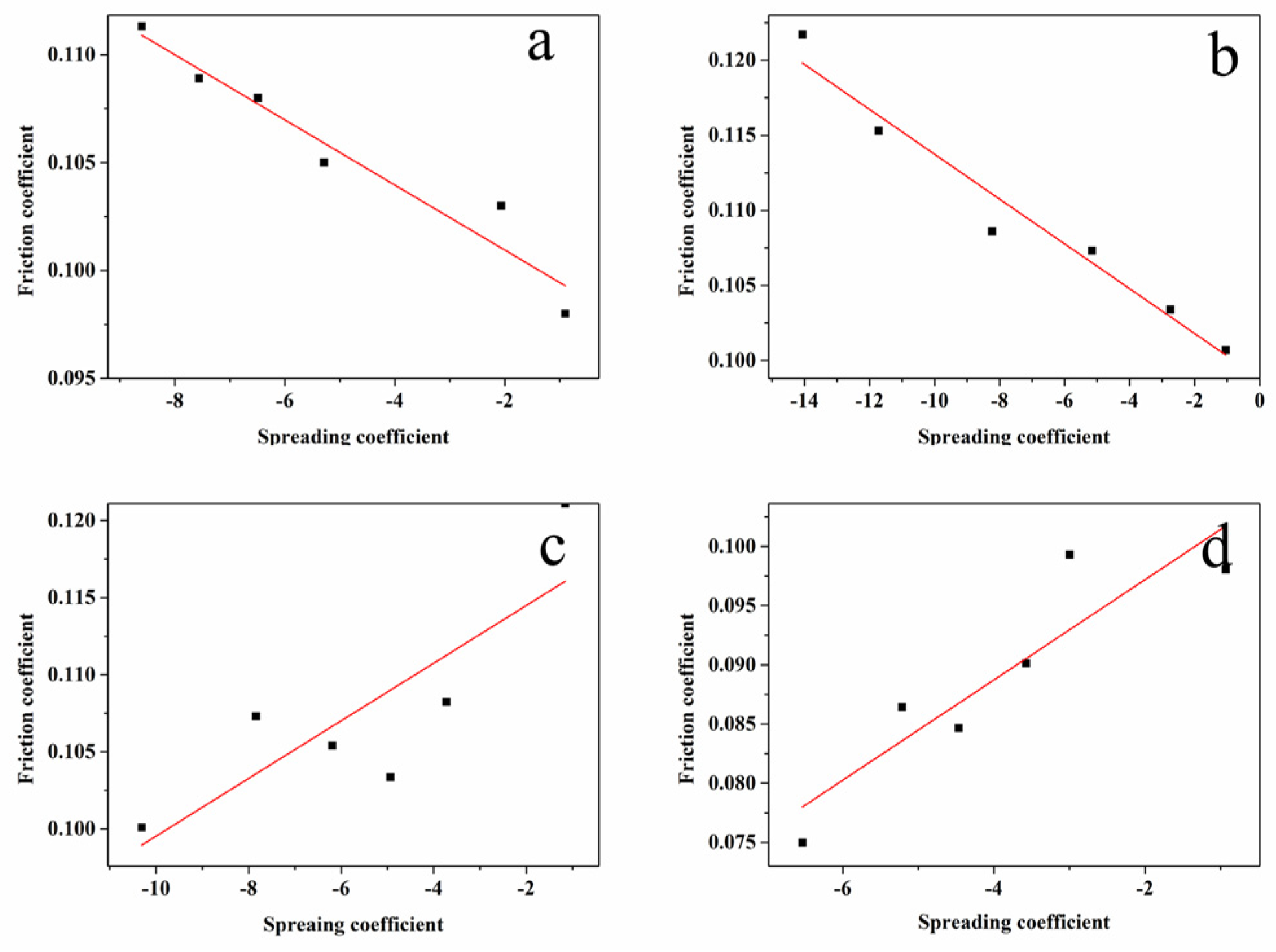
4.2. Lubrication Mechanisms
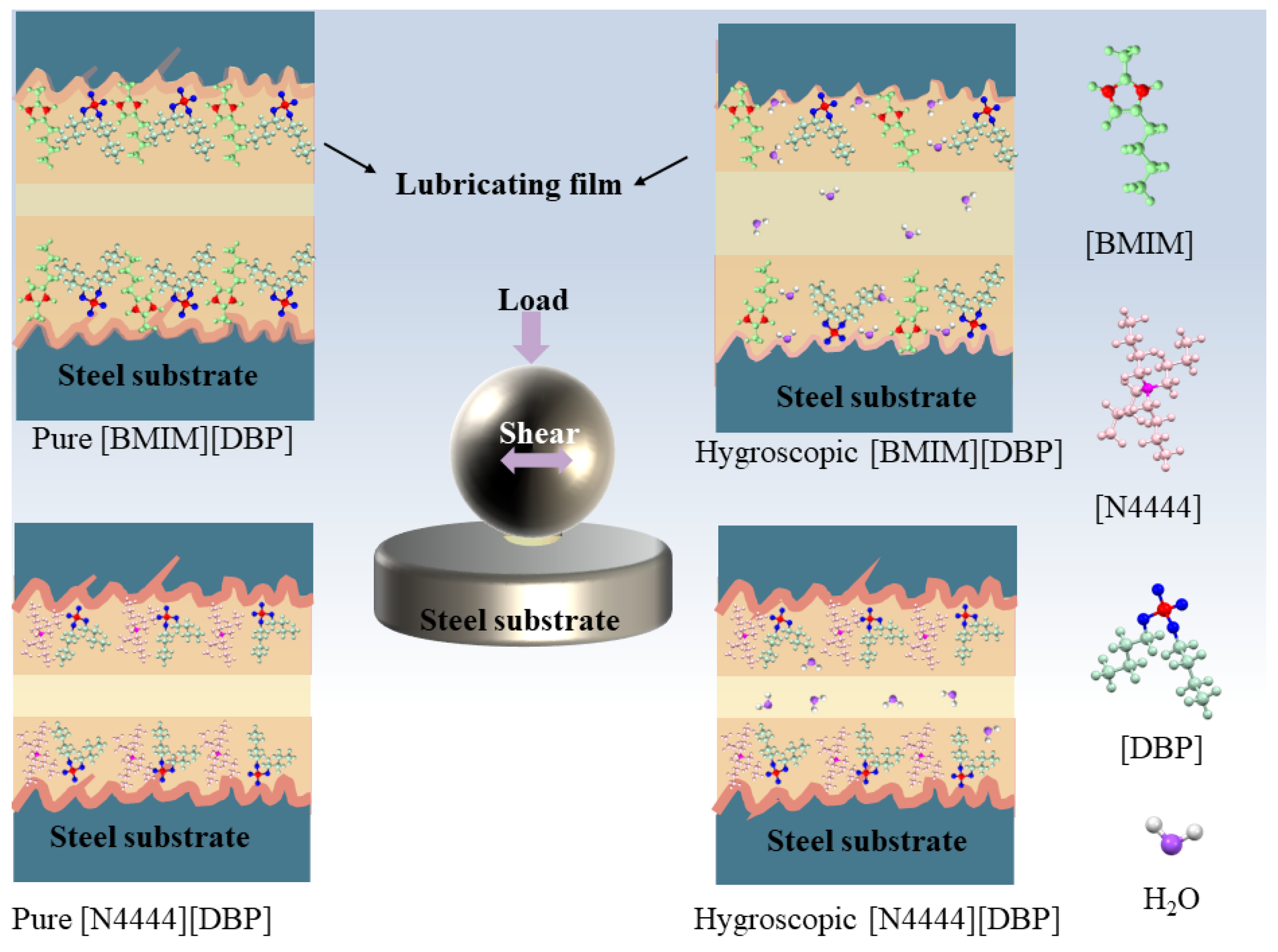
5. Conclusions
Supplementary Materials
Author Contributions
Funding
Data Availability Statement
Conflicts of Interest
References
- Cai, M.; Yu, Q.; Liu, W.; Zhou, F. Ionic liquid lubricants: When chemistry meets tribology. Chem. Soc. Rev. 2020, 49, 7753–7818. [Google Scholar] [CrossRef]
- Zhou, Y.; Qu, J. Ionic liquids as lubricant additives: A review. ACS Appl. Mater. Interfaces 2017, 9, 3209–3222. [Google Scholar] [CrossRef] [PubMed]
- Zhao, Q.; Li, Y.; Wu, X.; Ma, R.; Zhao, G.; Wang, X. A tribological study of DIPE esters containing ionic liquids as high temperature and heavy load lubricants. Tribol. Int. 2020, 142, 105971. [Google Scholar] [CrossRef]
- Keller, A.; Karlson, K.-O.; Grebe, M.; Schüler, F.; Goehringer, C.; Epp, A. Practical Evaluation of Ionic Liquids for Application as Lubricants in Cleanrooms and under Vacuum Conditions. Lubricants 2024, 12, 194. [Google Scholar] [CrossRef]
- Chen, W.; Feng, Y.; Wan, Y.; Zhang, L.; Yang, D.; Gao, X.; Yu, Q.; Wang, D. Investigation on anti-wear and corrosion-resistance behavior of steel-steel friction pair enhanced by ionic liquid additives under conductive conditions. Tribol. Int. 2023, 177, 108002. [Google Scholar] [CrossRef]
- Shaikh, S.; Sadeghi, M.; Cruz, S.; Ferreira, F. Recent Progress on the Tribology of Pure/Doped Diamond-like Carbon Coatings and Ionic Liquids. Coatings 2024, 14, 71. [Google Scholar] [CrossRef]
- Song, W.; Zhang, J.; Campen, S.; Yan, J.; Ji, H.; Wong, J.S.S. Lubrication mechanism of a strong tribofilm by imidazolium ionic liquid. Friction 2023, 11, 425–440. [Google Scholar]
- Yu, Q.; Zhang, C.; Dong, R.; Shi, Y.; Wang, Y.; Bai, Y.; Zhang, J.; Cai, M.; Zhou, F.; Liu, W. Physicochemical and tribological properties of gemini-type halogen-free dicationic ionic liquids. Friction 2021, 9, 344–355. [Google Scholar] [CrossRef]
- Wang, B.; Qin, L.; Mu, T.; Xue, Z.; Gao, G. Are Ionic Liquids Chemically Stable? Chem. Rev. 2017, 117, 7113–7131. [Google Scholar] [CrossRef]
- Gardas, R.L.; Ge, R.; Ab Manan, N.; Rooney, D.W.; Hardacre, C. Interfacial tensions of imidazolium-based ionic liquids with water and n-alkanes. Fluid. Phase Equilib. 2010, 294, 139–147. [Google Scholar]
- Yu, L.; Huang, J.; Wang, S.; Qi, L.; Wang, S.; Chen, C. Ionic Liquid “Water Pocket” for Stable and Environment-Adaptable Aqueous Zinc Metal Batteries. Adv. Mater. 2023, 35, 2210789. [Google Scholar] [CrossRef]
- Swatloski, R.P.; Holbrey, J.D.; Rogers, R.D. Ionic liquids are not always green: Hydrolysis of 1-butyl-3-methylimidazolium hexafluorophosphate. Green. Chem. 2003, 5, 361–363. [Google Scholar] [CrossRef]
- Barnhill, W.C.; Qu, J.; Luo, H.; Meyer, H.M., III; Ma, C.; Chi, M.; Papke, B.L. Phosphonium-Organophosphate Ionic Liquids as Lubricant Additives: Effects of Cation Structure on Physicochemical and Tribological Characteristics. ACS Appl. Mater. Interfaces 2014, 6, 22585–22593. [Google Scholar] [CrossRef]
- Huang, G.; Fan, S.; Ba, Z.; Cai, M.; Qiao, D. Insight into the lubricating mechanism for alkylimidazolium phosphate ionic liquids with different alkyl chain length. Tribol. Int. 2019, 140, 105886. [Google Scholar] [CrossRef]
- Ba, Z.; Huang, G.; Qiao, D.; Feng, D. Experimental and calculation studies on the relationship between the hygroscopic behavior and lubrication properties of ionic liquids. Appl. Surf. Sci. 2020, 529, 147031. [Google Scholar] [CrossRef]
- Akira, Y.; Masatoshi, O. Destruction of the Water Layer on a Hydrophobic Surface Induced by the Forced Approach of Hydrophilic and Hydrophobic Cations. J. Phys. Chem. Lett. 2010, 1, 1487–1491. [Google Scholar] [CrossRef]
- Han, Y.; Qiao, D.; Zhang, L.; Feng, D. Study of tribological performance and mechanism of phosphonate ionic liquids for steel/aluminum contact. Tribol. Int. 2015, 84, 71–80. [Google Scholar] [CrossRef]
- Biovia, D.S. Materials Studio. R2; Dassault Systèmes BIOVIA: San Diego, CA, USA, 2017. [Google Scholar]
- Sun, H. COMPASS: An ab initio force-field optimized for condensed-phase applications overview with details on alkane and benzene compounds. J. Phys. Chem. B 1998, 102, 7338–7364. [Google Scholar] [CrossRef]
- Shuichi, N. Constant temperature molecular dynamics methods. Prog. Theor. Phys. Suppl. 1991, 103, 1–46. [Google Scholar] [CrossRef]
- Cao, Y.; Chen, Y.; Sun, X.; Zhang, Z.; Mu, T. Water sorption in ionic liquids: Kinetics, mechanisms and hydrophilicity. Phys. Chem. Chem. Phys. 2012, 14, 12252–12262. [Google Scholar] [CrossRef]
- Angelica, M.; Andrea, M.; Janusz, N.; Justyna, Ł.; Lorenzo, G. Betaine and l-carnitine ester bromides: Synthesis and comparative study of their thermal behaviour and surface activity. J. Mol. Liq. 2021, 334, 115988. [Google Scholar] [CrossRef]
- Lin, L.; Kedzierski, M.A. Density and viscosity of a polyol ester lubricant: Measurement and molecular dynamics simulation. Int. J. Refrig. 2020, 118, 188–201. [Google Scholar] [CrossRef] [PubMed]
- Stanković, I.; Dašić, M.; Jovanović, M.; Martini, A. Effects of Water Content on the Transport and Thermodynamic Properties of Phosphonium Ionic Liquids. Langmuir 2024, 40, 9049–9058. [Google Scholar] [CrossRef] [PubMed]
- Cai, J.; Liu, J.; Mu, S.; Liu, J.; Hong, J.; Zhou, X.; Ma, Q.; Shi, L. Corrosion Inhibition Effect of Three Imidazolium Ionic Liquids On Carbon Steel In Chloride Contaminated Environment. Int. J. Electrochem. Sci. 2020, 15, 1287–1301. [Google Scholar] [CrossRef]
- Sonia, R.; Sushil Kumar, S.S.; Chandrabhan, V.; Saif Ali, C.; Shriniwas, G. Evaluation of inhibition performance of methylimidazolium ionic liquids on surface of mild steel in sulfuric acid. Surf. Coat. Technol. 2024, 485, 130875. [Google Scholar]
- Khan, A.M.; Wu, H.; Ma, Q.; Chung, Y.-W.; Wang, Q.J. Relating Tribological Performance and Tribofilm Formation to the Adsorption Strength of Surface-Active Precursors. Tribol. Lett. 2019, 68, 6. [Google Scholar] [CrossRef]
- Sabine, M.; Miquel, S. Adsorption of Water. Surf. Interface Sci. 2015, 357–390. [Google Scholar] [CrossRef]
- Schiros, T.; Ogasawara, H.; Näslund, L.Å.; Andersson, K.J.; Ren, J.; Meng, S.; Karlberg, G.S.; Odelius, M.; Nilsson, A.; Pettersson, L.G. Cooperativity in Surface Bonding and Hydrogen Bonding of Water and Hydroxyl at Metal Surfaces. J. Phys. Chem. C 2010, 114, 10240–10248. [Google Scholar] [CrossRef]
- McCrum, I.T.; Hickner, M.A.; Janik, M.J. Quaternary Ammonium Cation Specific Adsorption on Platinum Electrodes: A Combined Experimental and Density Functional Theory Study. J. Electrochem. Soc. 2018, 165, J3009–J3016. [Google Scholar] [CrossRef]
- Fajardo, O.Y.; Bresme, F.; Kornyshev, A.A.; Urbakh, M. Water in Ionic Liquid Lubricants: Friend and Foe. ACS Nano 2017, 11, 6825–6831. [Google Scholar] [CrossRef]
- Yu, Q.; Zhang, C.; Wang, J.; Fan, F.; Yang, Z.; Zhou, X.; Tang, Z.; Cai, M.; Zhou, F. Tribological performance and lubrication mechanism of new gemini quaternary phosphonium ionic liquid lubricants. J. Mol. Liq. 2021, 322, 114522. [Google Scholar] [CrossRef]
- ISolovyova, I.V.; Yang, S.; Starovoytov, O.N. Molecular dynamics simulation studies of 1,3-dimethyl imidazolium nitrate ionic liquid with water. J. Chem. Phys. 2023, 158, 024502. [Google Scholar] [CrossRef]
- Stephan, S.; Schmitt, S.; Hasse, H.; Urbassek, H.M. Molecular dynamics simulation of the Stribeck curve: Boundary lubrication, mixed lubrication, and hydrodynamic lubrication on the atomistic level. Friction 2023, 11, 2342–2366. [Google Scholar] [CrossRef]
- Liu, T.; Panwar, P.; Khajeh, A.; Rahman, M.H.; Menezes, P.L.; Martini, A. Review of Molecular Dynamics Simulations of Phosphonium Ionic Liquid Lubricants. Tribol. Lett. 2022, 70, 44. [Google Scholar] [CrossRef]
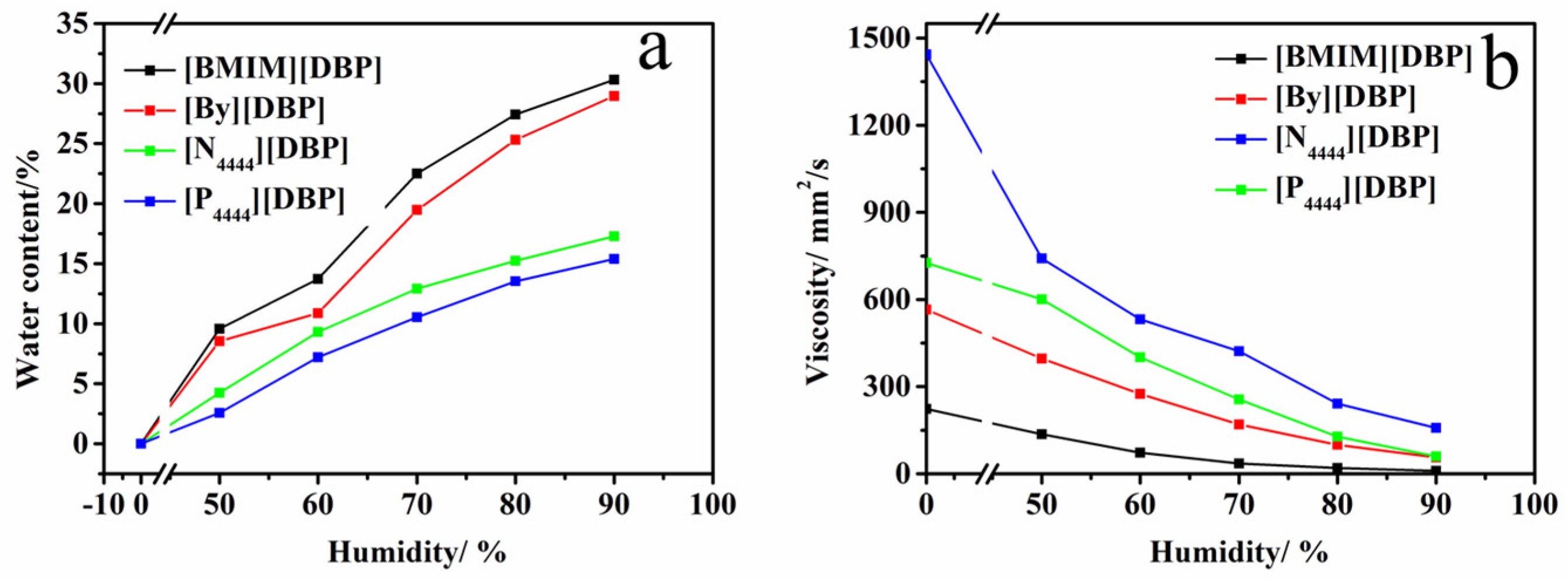
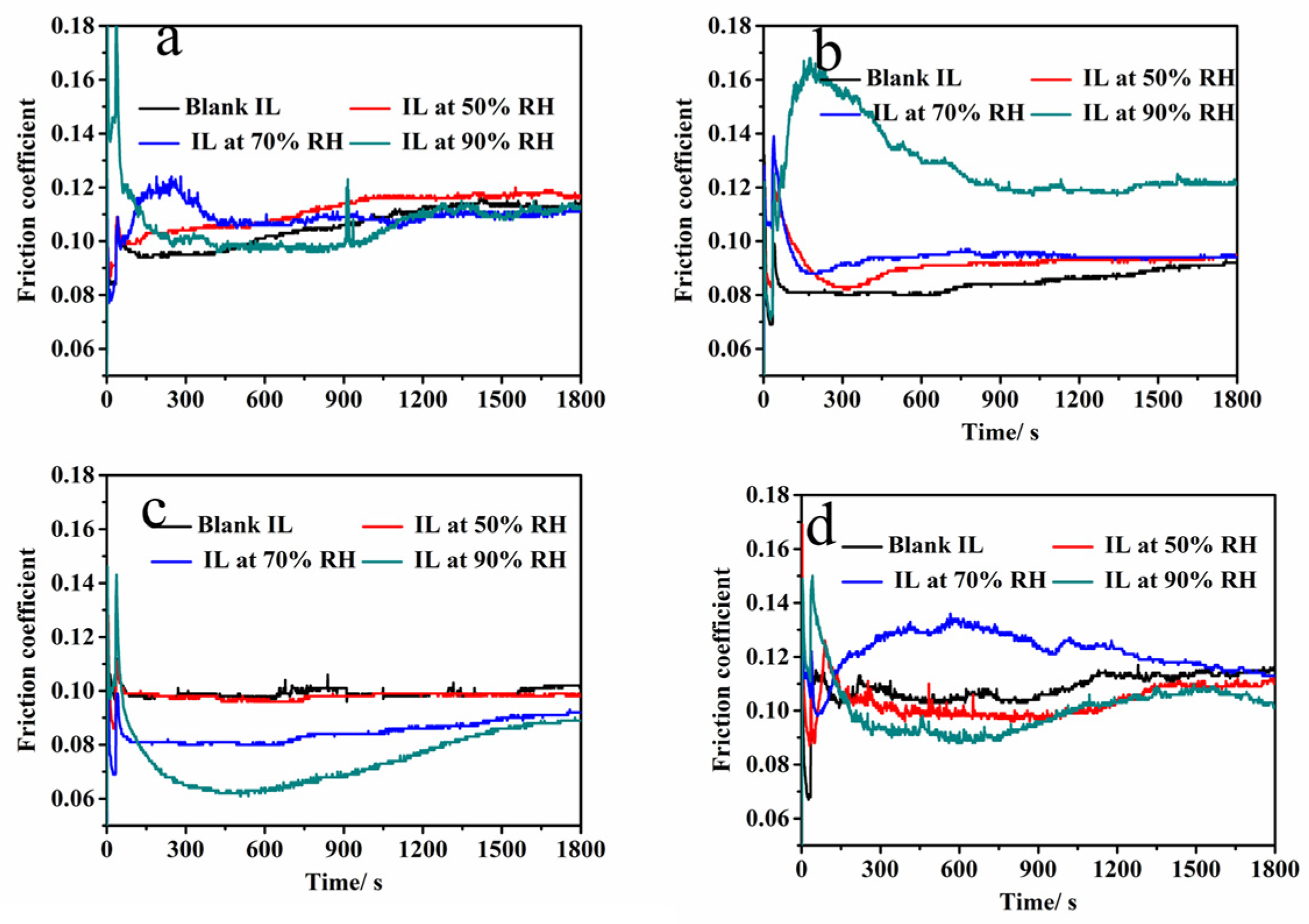


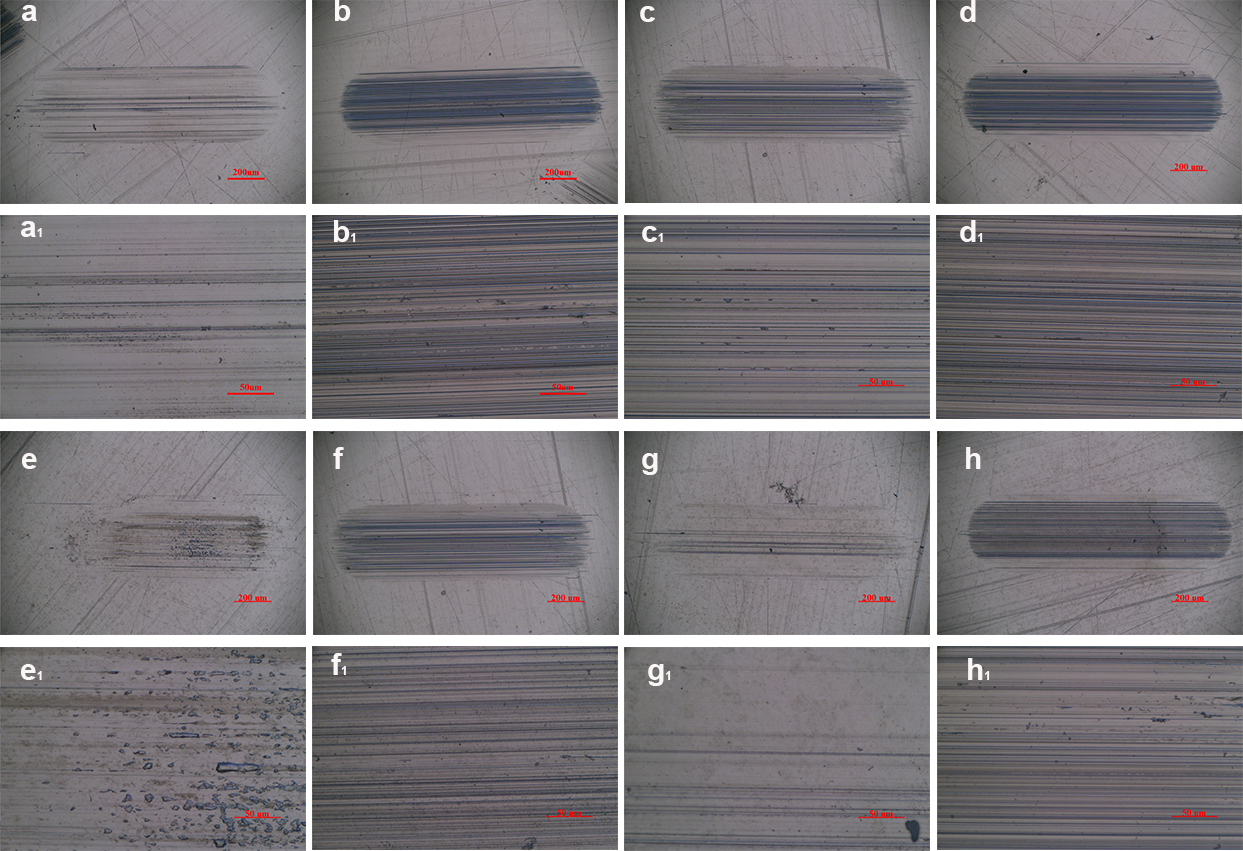
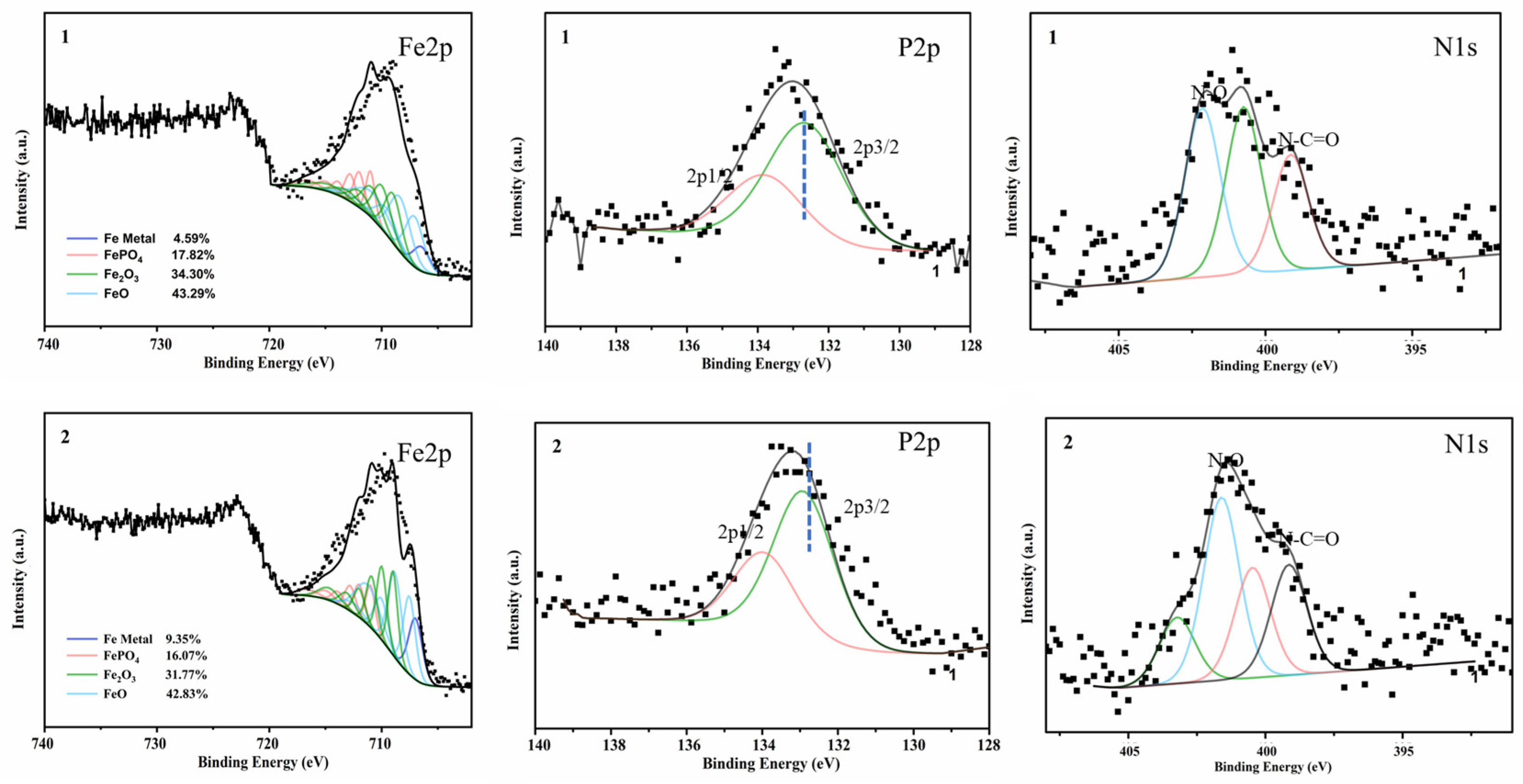
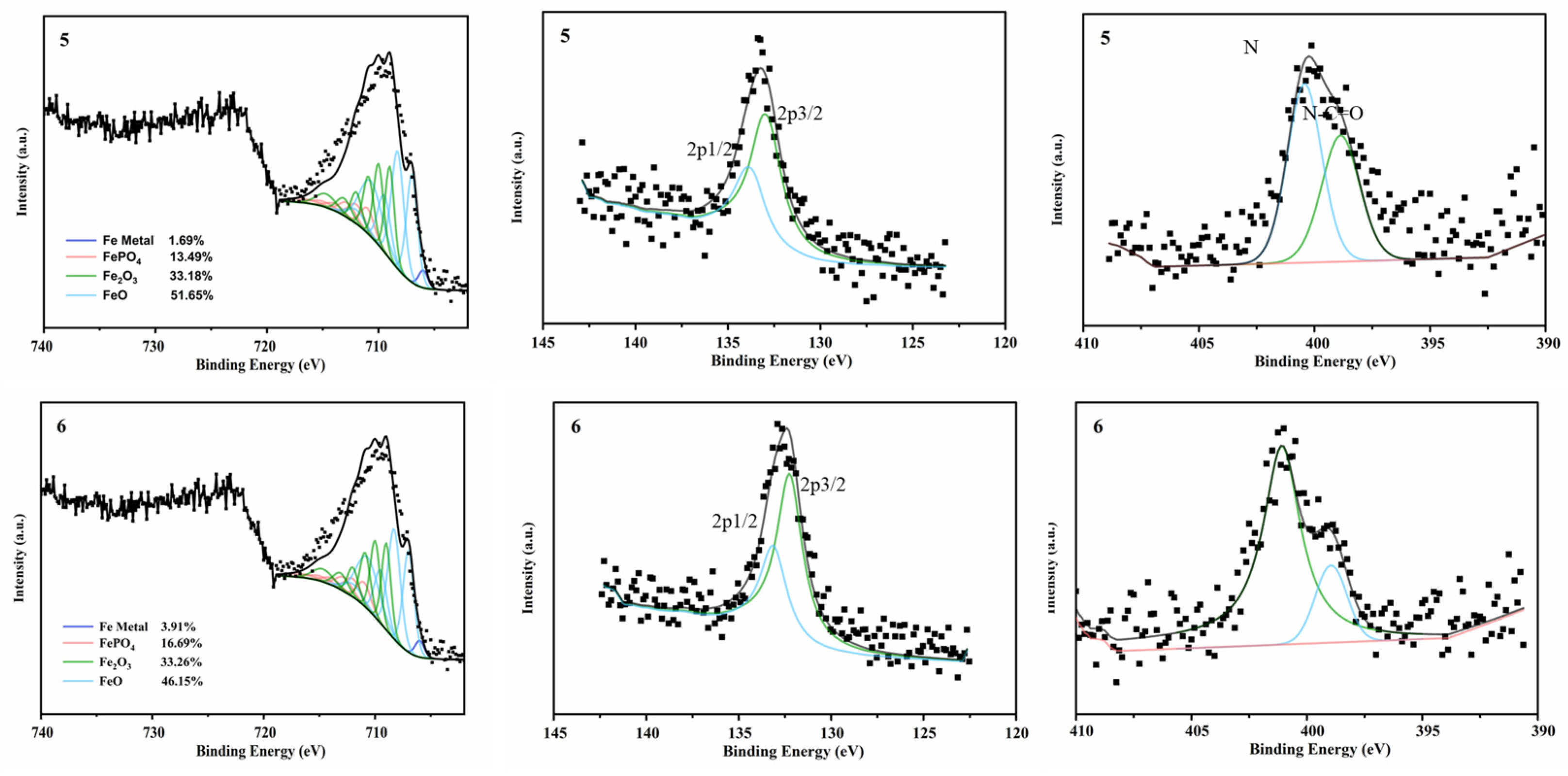
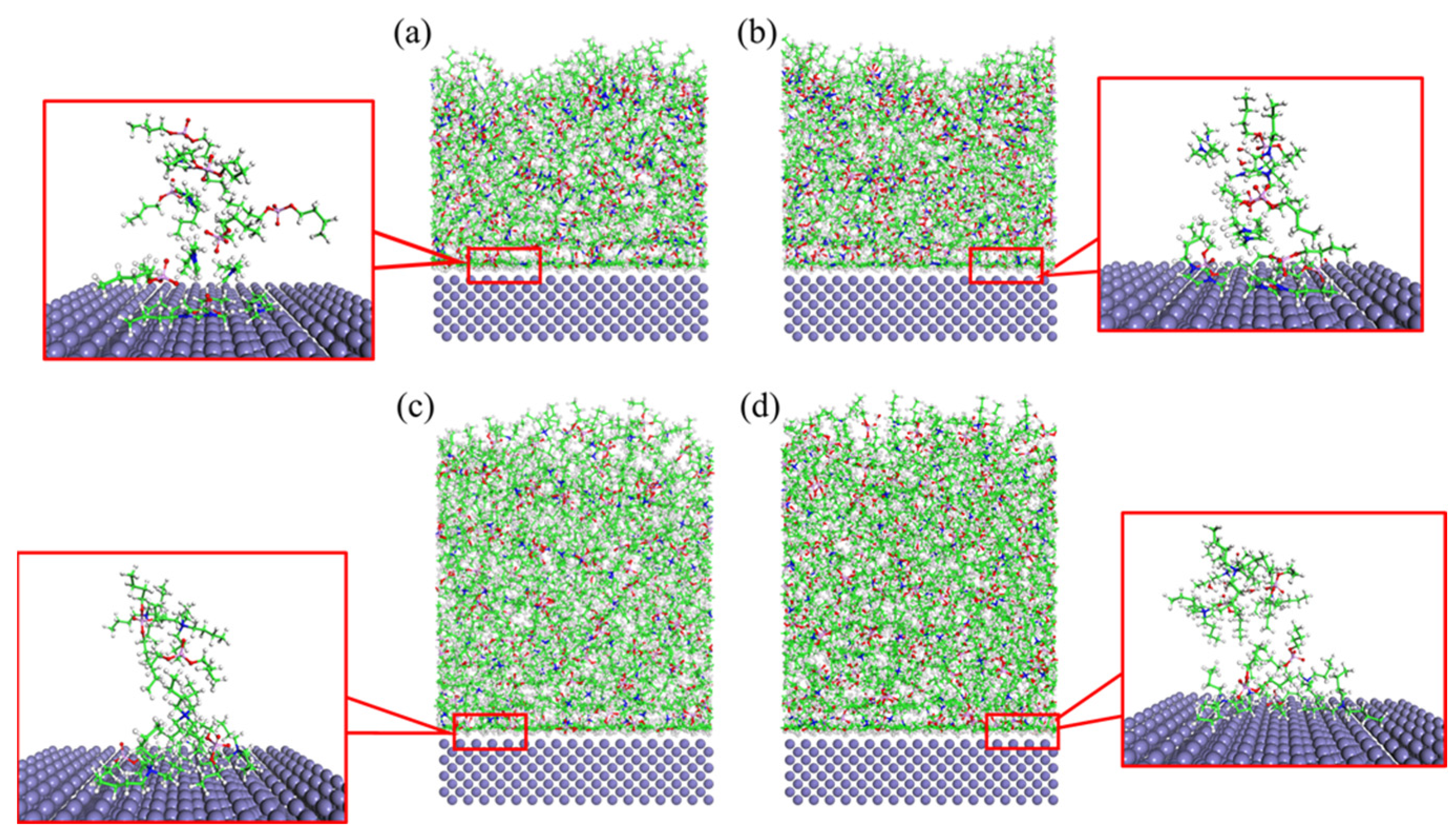
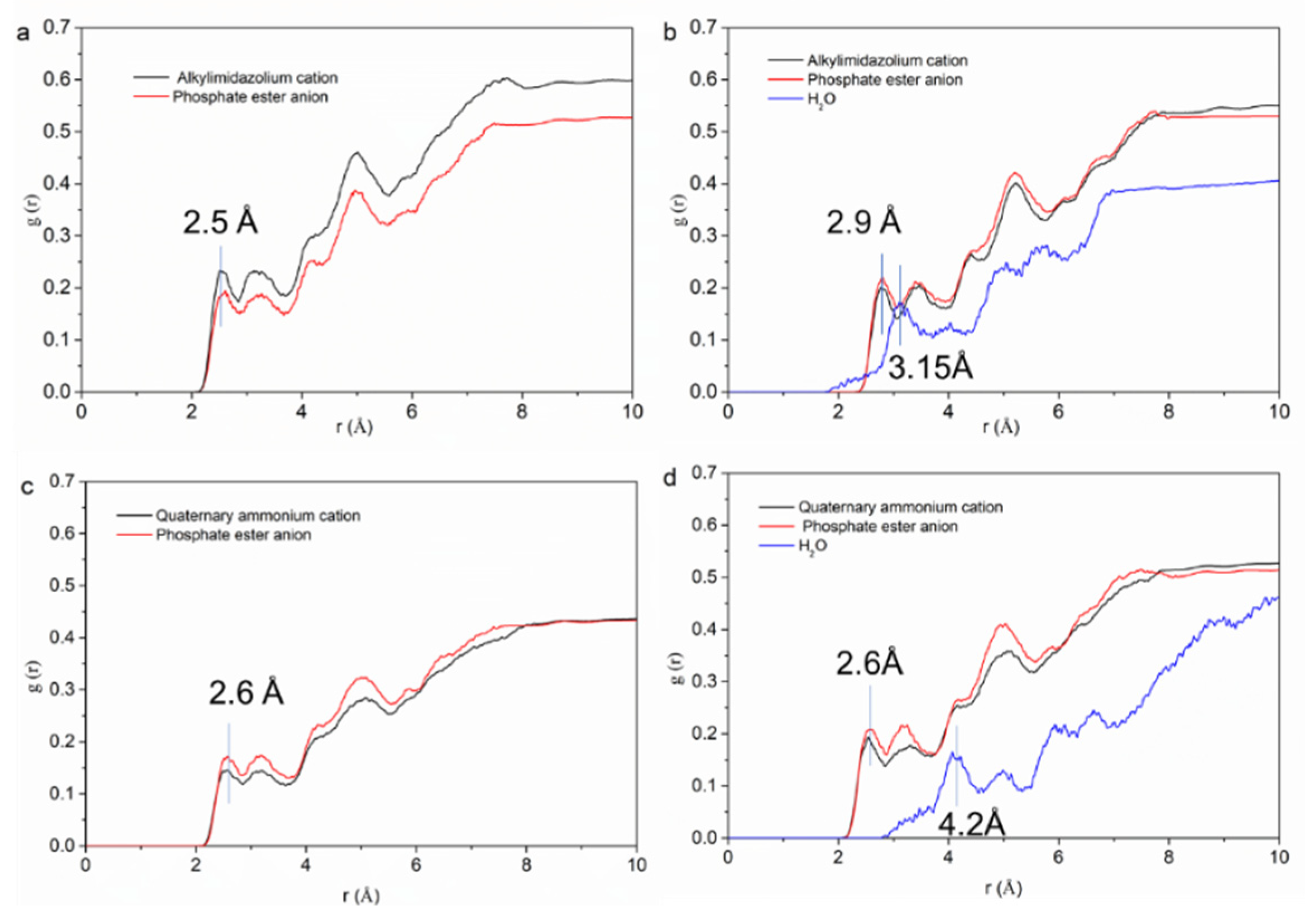
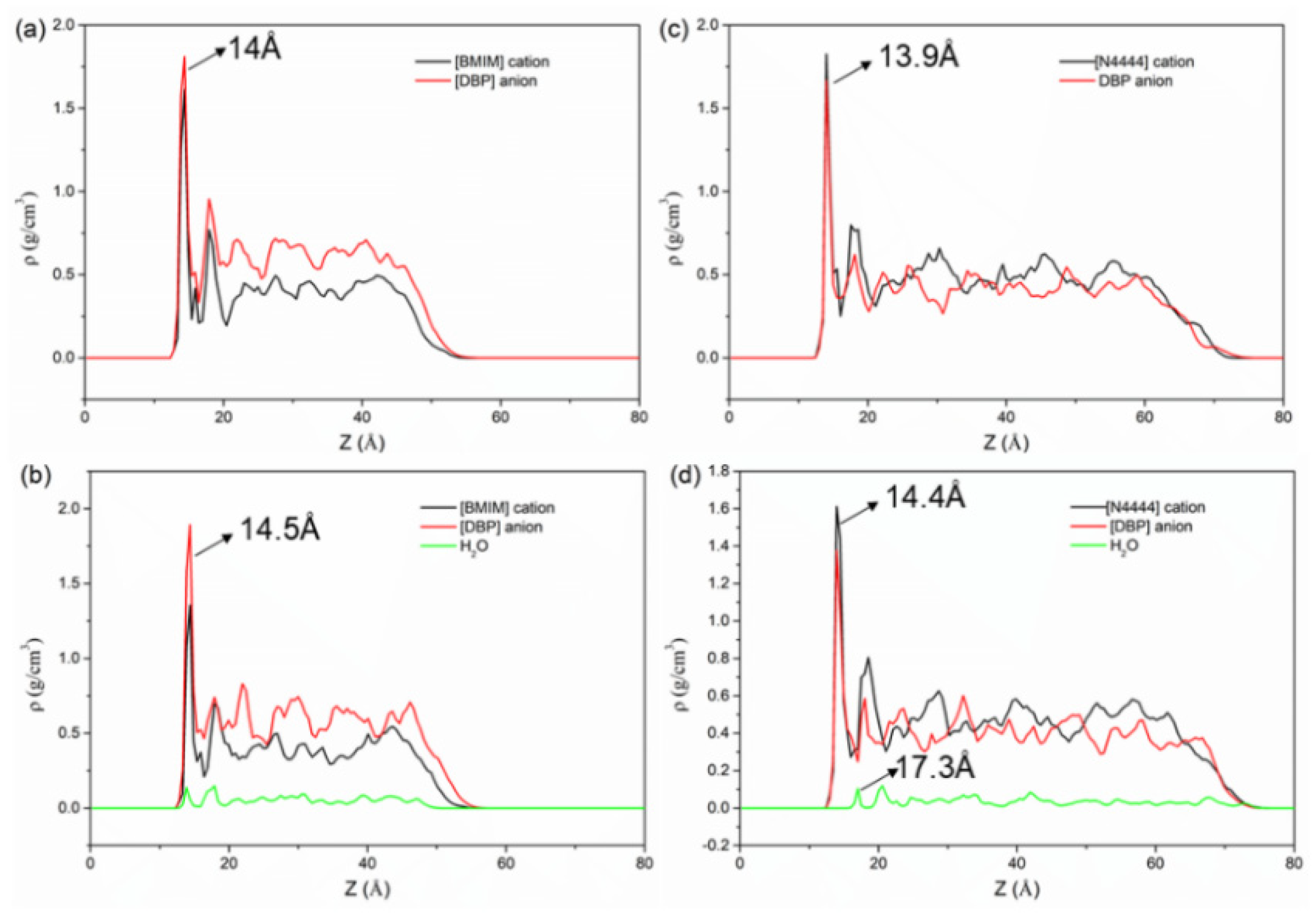
| Full Name | Abbreviation | Structure |
|---|---|---|
| 1-butyl-3-methylimidazolium dibutylphosphate | [BMIM] [DBP] |  |
| N-butyl pyridinium dibutyl-phosphate | [By] [DBP] |  |
| tetrabutyl-ammonium dibutyl-phosphate | [N4444] [DBP] |  |
| tetrabutyl-phosphonium dibutyl-phosphate | [P4444] [DBP] |  |
| ILs | Humidity/% | (mJ/m2) | (°) | S (mJ/m2) |
|---|---|---|---|---|
| [BMIM] [DBP] | 0 | 42.6 | 11.81 | −0.90 |
| 50 | 43.1 | 17.8 | −2.06 | |
| 60 | 44.5 | 28.22 | −5.29 | |
| 70 | 46.7 | 30.57 | −6.50 | |
| 80 | 48.4 | 32.46 | −7.56 | |
| 90 | 49.3 | 34.36 | −8.60 | |
| [By] [DBP] | 0 | 43.1 | 12.6 | −1.04 |
| 50 | 44.2 | 20.3 | −2.75 | |
| 60 | 46.3 | 27.3 | −5.16 | |
| 70 | 47.5 | 34.24 | −8.23 | |
| 80 | 48.9 | 40.51 | −11.72 | |
| 90 | 49.5 | 44.29 | −14.07 | |
| [N4444] [DBP] | 0 | 30.5 | 14.19 | −0.93 |
| 50 | 30.3 | 25.7 | −3.00 | |
| 60 | 30.9 | 27.83 | −3.57 | |
| 70 | 31.7 | 30.78 | −4.47 | |
| 80 | 32.1 | 33.12 | −5.22 | |
| 90 | 32.5 | 36.97 | −6.53 | |
| [P4444] [DBP] | 0 | 31.3 | 15.64 | −1.16 |
| 50 | 31.5 | 28.15 | −3.73 | |
| 60 | 32.2 | 32.14 | −4.93 | |
| 70 | 32.8 | 35.79 | −6.19 | |
| 80 | 33.1 | 40.25 | −7.84 | |
| 90 | 33.8 | 45.97 | −10.31 |
| Systems | Interaction Energy (kcal·mol−1) | |
|---|---|---|
| Without H2O | Without H2O | |
| [BMIM]-Fe (001) | −1904.67 | −1662.07 |
| [N4444]-Fe (001) | −2152.13 | −2153.48 |
Disclaimer/Publisher’s Note: The statements, opinions and data contained in all publications are solely those of the individual author(s) and contributor(s) and not of MDPI and/or the editor(s). MDPI and/or the editor(s) disclaim responsibility for any injury to people or property resulting from any ideas, methods, instructions or products referred to in the content. |
© 2025 by the authors. Licensee MDPI, Basel, Switzerland. This article is an open access article distributed under the terms and conditions of the Creative Commons Attribution (CC BY) license (https://creativecommons.org/licenses/by/4.0/).
Share and Cite
Ba, Z.; Qiao, D.; Feng, D.; Zhang, J. Humidity-Driven Interfacial Restructuring of Lubricating Films in Phosphate Ester Ionic Liquids: Aromatic vs. Aliphatic Cation Effects. Lubricants 2025, 13, 475. https://doi.org/10.3390/lubricants13110475
Ba Z, Qiao D, Feng D, Zhang J. Humidity-Driven Interfacial Restructuring of Lubricating Films in Phosphate Ester Ionic Liquids: Aromatic vs. Aliphatic Cation Effects. Lubricants. 2025; 13(11):475. https://doi.org/10.3390/lubricants13110475
Chicago/Turabian StyleBa, Zhaowen, Dan Qiao, Dapeng Feng, and Jian Zhang. 2025. "Humidity-Driven Interfacial Restructuring of Lubricating Films in Phosphate Ester Ionic Liquids: Aromatic vs. Aliphatic Cation Effects" Lubricants 13, no. 11: 475. https://doi.org/10.3390/lubricants13110475
APA StyleBa, Z., Qiao, D., Feng, D., & Zhang, J. (2025). Humidity-Driven Interfacial Restructuring of Lubricating Films in Phosphate Ester Ionic Liquids: Aromatic vs. Aliphatic Cation Effects. Lubricants, 13(11), 475. https://doi.org/10.3390/lubricants13110475




